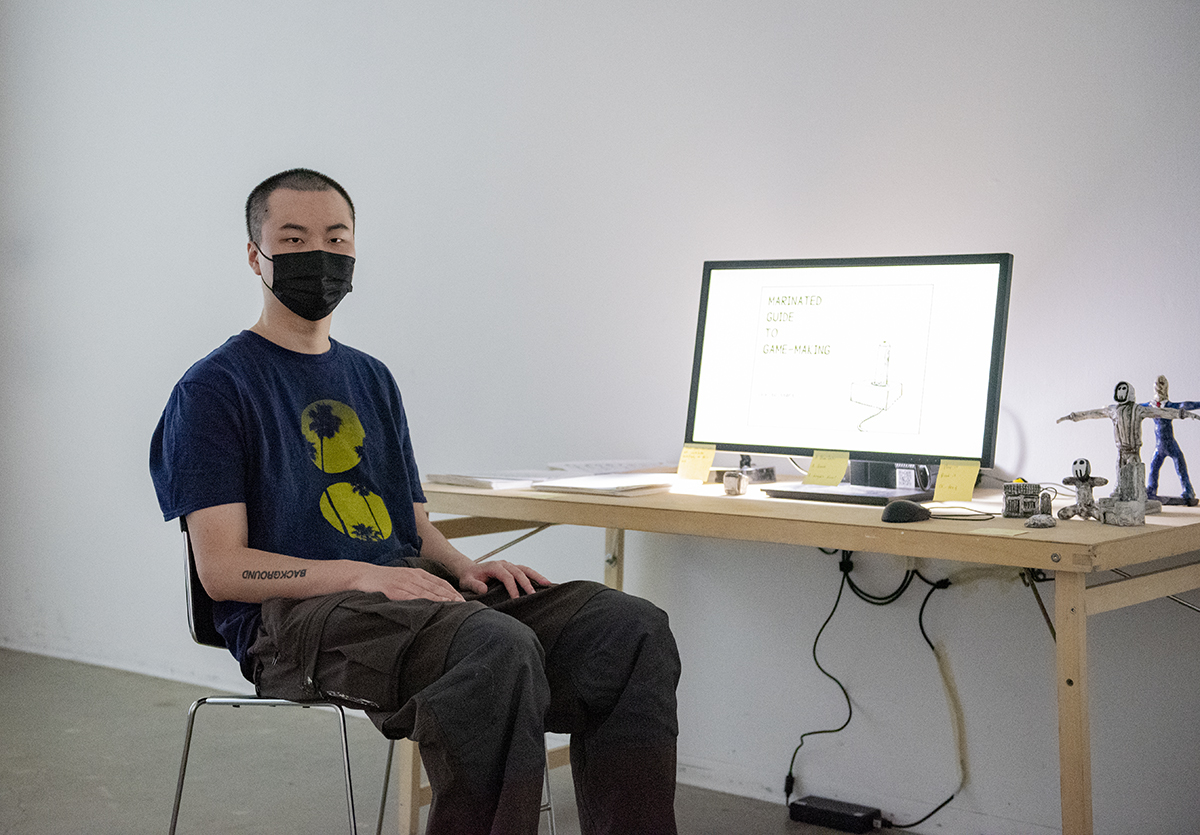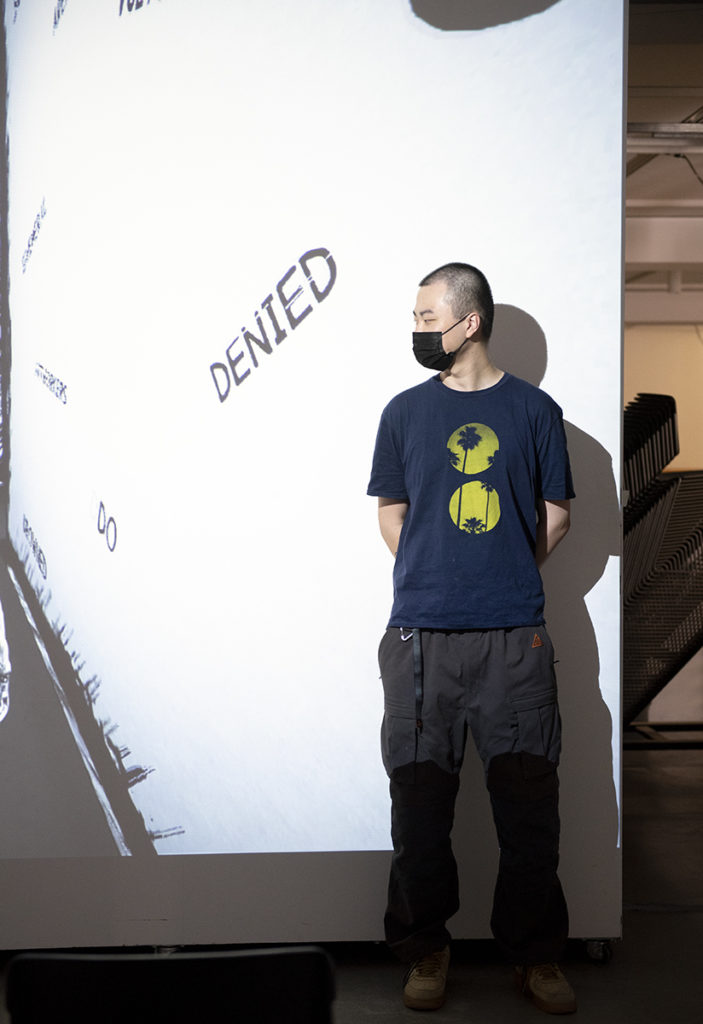Graduate student commentates on rigid art world through experimental game design

Design media arts graduate student Michael Luo sits at a desk topped by a computer and three small figures. Luo’s solo graduate exhibition, which features three video games, will run from Tuesday to Thursday. (August Suchecki/Daily Bruin)
“ YOU MAY THINK THEY LOVE YOU FOR YOUR GAMES, BUT ALL THEY ACTUALLY WANT ARE SPECTACULARLY WEIRD TOYS FOR THEIR SHINY, BRAND NEW 8K QLED SMART SCREENS.”
UCLA DMA Graduate Gallery
Broad Art Center, 1st Floor
April 12-14
By Natalie Brown
April 12, 2022 3:27 p.m.
This post was updated April 26 at 10:52 p.m.
In terms of experimentalism, one artist is not playing games.
From Tuesday to Thursday, design media arts graduate student Michael Luo’s solo exhibition will be on display in the Broad Art Center. Entitled “YOU MAY THINK THEY LOVE YOU FOR YOUR GAMES, BUT ALL THEY ACTUALLY WANT ARE SPECTACULARLY WEIRD TOYS FOR THEIR SHINY, BRAND NEW 8K QLED SMART SCREENS.,” the showcase is infused with witty humor, providing apt social commentary on the rigidity of the art world and everyday life, Luo said. In contrast to other popular art shows that aim to find a singular word to encapsulate the complexity of their works, Luo said he wanted to deviate from convention and opt for a lengthier, Bob Dylan-inspired exhibition name that foreshadows his subversive artistic identity.
“With the ongoing commodification of media arts, everything has to look shiny (or) look like an NFT,” he said. “These (media arts projects) are probably going to end up being a toy on their (people’s) screens.”
Luo said his exhibition, consisting of three separate games working together to form a cohesive and personal narrative, deviates from the art world’s expectations of traditional game layout. While most commercial games are designed to be played for hundreds of hours, Luo said he wanted to condense a game into an easily digestible experience that was less than ten minutes in length – operating almost like a few songs in a much larger game album he hopes to develop.

[Related: Student adds life to her game designs with complex characters, fantasy elements]
The first game, “Press W To Move Forward,” is an experimentation with the horror game genre. As the title suggests, he said, players can only press W to advance onwards. Inspired by societal pressures to keep moving forward both academically and professionally, Luo said he wanted to demonstrate the toxicity in this mentality, alluding to its overall self-destructiveness.
After the event’s attendees resonate with the themes of the first game, Luo said they are invited to experience the second game, “Museum of Mediocre Appropriations” – a play on the Museum of Modern Art, often abbreviated to MoMA. Luo said the game, which requires no audience intervention, guides attendees through a simulated experience in a trendy museum, critiquing the contemporary media arts landscape.
The experience is swiftly followed by the final experience, “Marinated Guide to Game Making,” which uses direct quotes from introductory game-making books in its aesthetic, subverting the notion of conventionality and standard practices in game making, he said. There is a very direct sense of humor and self-reflexivity that connects these three games from a conceptual standpoint, he said, though their artistic elements vary.
“They (the three games) speak to each other, but they all have different aesthetics,” Luo said. “One uses pure 3D products, one features my own hand drawings and comics, and one mixes all of those together.”
Using different media to craft each game’s individualism, Luo received assistance from alumnus and ArtCenter College of Design student Chloe Zhang to diversify his games’ aesthetics. Crafting a 3D hallway and office chair for his project, Zhang said her contribution to the exhibition allowed for an increased sense of realism that directly translates to a more immersive overall audience experience. Testing out the games herself, she said she felt like she was actually moving through a hallway in real life.
The diverse aesthetics play into the much larger commentary Luo aims to provide, he said. In the art world, Luo said video games have typically been credited as a form of low art – something reserved for children. By combining a socially perceived low art form with other mediums, including Zhang’s work, sketches, comics and horror-film derived elements, Luo said he creates a bold aesthetic that stands up against the art world’s hierarchical practices, demonstrating that these forms are all worthy of being exhibited in a standard gallery format.
It is this same experimental fervor that differentiates Luo’s work from other artists’, said assistant professor at the department of design media arts Jenna Caravello. As Luo’s mentor, Caravello said the pair had several conversations regarding the idea of subverting the language of games to create a deeply personal and innovative gaming experience. However, this goal does not come without its challenges, she said.
“Being an experimental artist who is working with games as a platform is complicated because you’re in dialogue with the history of a platform that has been pretty homogenous, rigid and tied to cliches and tropes,” Caravello said.
[Related: Graduate student discusses art, technology in ‘Software for Artists Book’]
Finding the ideal balance between playability and being informative with an artistic vision is a critical question that needs to be answered when making polemical art games, she said. However, with the assistance of Zhang, Caravello, resources like YouTube and the UCLA Game Lab, Luo said he was able to strike this balance. Grateful to have found a community that supported his practice and helped him build these games together, Luo said he hopes artists in the future will prioritize community over collective success, pushing similar experimental commentaries forward.
“I hope my games serve a didactic function to people who play them,” Luo said. “1000 people might hate one of my games, and 10 of them might like it – I don’t care. But one person, even just one person might like it … I just want to motivate them to push the medium forward themselves.”

